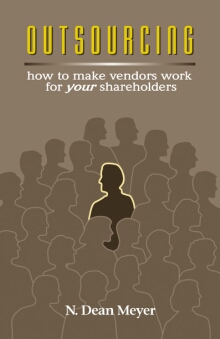| Excerpt from www.NDMA.COM, © 2025 N. Dean Meyer and Associates Inc.
Analysis: Outsourcing
how to ensure that vendors work for your shareholders
by N. Dean Meyer
No trend characterizes the stresses on corporations better than outsourcing. Executives look to outsourcing to save money, improve performance, and spend less time worrying about a service function. In reality, the promised benefits rarely materialize. In too many cases, outsourcing doesn't save money at all. In fact, just the opposite, paying vendors a profit turns out to be surprisingly expensive. Worse, vendors can never be as well aligned with business strategies as insiders. Furthermore, outsourcing contracts are often tough to manage, distracting management with complex legal negotiations. Meanwhile, outsourcing can cripple the flexibility of an organization and decimate the careers of colleagues and friends.
Outsourcing Versus Extended StaffingSome people think that success with outsourcing is simply a matter of choosing the right vendor and cutting the right deal. These folks may be in for a rude awakening. The difference between fruitful partnerships with vendors and outsourcing nightmares is more a matter of how you decide when to use vendors (versus internal staff), and how well you manage those vendors once you've hired them. To utilize vendors effectively, executives must see through the hype of their sales pitches and understand the fundamental trade-offs between vendors and internal staff. Then, rather than venting their frustrations with internal staff by throwing entire organizations out the door, executives must build healthy internal organizations, where competent staff decide "make-versus-buy" in a fact-based manner, case by case, day after day, and where staff use their specialized expertise to manage vendors to internal standards of excellence. In other words, successful management of vendors starts with the effective management of internal staff. This thesis may be counter-intuitive, since outsourcing is generally viewed as an alternative to internal staff. Recognizing that executives' interest in outsourcing often reflects frustration with internal staff, consider the typical sources of dissatisfaction and their root causes. This leads to an understanding of what it takes to make internal service providers competitive alternatives to outsourcing. It also provides a basis for analyzing the differential advantages of internal staff and vendors.
Entrepreneurial StaffOne aspect of a healthy internal service provider is its proactive use of vendors -- not as a replacement for its staff, but as an extension of its staff. This approach to managing vendors is called "extended staffing." A healthy culture provides guidelines for the effective use of vendors and contractors within the extended-staffing strategy. A high-performing internal service provider may have opportunities for "in-sourcing," which is the converse of outsourcing. Through in-sourcing, a internal staff may actually generate revenues (and other synergies) by offering their products and services to other companies.
SummaryIn summary, leaders must take a critical, analytical look at outsourcing -- the claims and fallacies, and the opportunities and risks. By examining the fundamental trade-offs, it will become evident how to make the most of vendors without incurring undue costs and risks. Careful analysis will make corporate executives smart buyers of outsourcing, and give staff the framework they need to make the best use of vendors while earning the position of clients' suppliers of choice.
|


